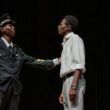There is no doubt that in the journey of life, one finds a course that determines his or her path into adulthood. Such a path is influenced by different experiences, intuitions, combined with personal aspirations. These can be defined at various stages of one’s life, as it happened to me.
Having been exposed to conspicuous inequalities, poverty and hopelessness in the far-flung village of Imelu, in Kitui; and with my family having migrated from Machakos in 1985, I joined the only primary school that was in the area – Kangala Primary School. The primary school was almost eight kilometres away from home. Being the first class eight in the school in 1988, we managed to do well and earned the school a divisional trophy. Having led in the best performing pupils, I joined Masii Secondary School in Machakos County in 1989, where I also did well to join Egerton University. The determination to see change and a better society with community development was already instilled in my mind at the village, primary and secondary school levels. I finished Form Four in 1992, the year the first multi-party elections were held after the repeal of Section 2(A) of the then Kenyan Constitution. The outcome of the elections was seriously contested. This led to the decade of the second liberation struggle in Kenya (the 1990s).
I joined Egerton University in June 1994 with nothing tangible in my hands except the well-wishers who had come to my rescue to ensure that I did not miss the opportunity to join the university. My parents had already said it was unaffordable for them with other siblings still in school. Such was the determination that I had, rooting for a better tomorrow through education. I had no wherewithal, however, I was fully in God’s hands and my trust in humanity, to come to my aid where hope was being crushed.
June 1994 when I joined the university, it was just one and half years after the country had emerged from the first multiparty elections following reintroduction of multiparty democracy. The environment was therefore one of anxiety as to how the political scene would evolve. I was a keen follower of current affairs, even while I was in High School. In the university, I tried my best not to miss the Sunday Nation newspaper. I followed the national events with keen attention on political developments around human rights discourses, political parties and alignments. By then, comments and articles by Dr Willy Mutunga, Professor Kivutha Kibwana, advocates Paul Muite, Gibson Kamau Kuria and many others, as well as public engagements through seminars, workshops and conferences, were the areas of my key attention. They were captivating, and the public engagements, mostly those planned in Nakuru, were transformative. I would save, sacrifice and do my best to attend them, especially from 1995 onwards.
The National Youth Movement then was a key youth mobilizer, with interactions from students from other universities. It is in these meetings where national issues and discourse were enhanced, building strong partnerships for effective engagements. Protests, picketing, sit-ins, demonstrations and riots in universities were rampant, not only in the universities but in the main towns of Kenya. In 1995, public engagements escalated with demands for student’s welfare, better services in the universities and clarity on payment of university fees. This was after introduction of the Higher Education Loans Board (HELB). Campus closures were the norm and youth meetings in Nakuru were enchanting, defining my turning point in public affairs.
On December 17, 1996, immediately after the campus reopened, Festus Okong’o Etaba (RIP), a first-year student, was shot and killed by police during one of the many demonstrations that was demanding for a partial refund of fees that was allegedly owed to students by the university. The students were unarmed and peaceful in that demonstration. This incident defined my long-term course for a better, democratic and people centred policing in Kenya. This call has remained alive to date. With death of Etaba, the campus was closed down again. Upon each closure of the university I could find solace in menial jobs in Nairobi, including on construction sites. All in all, my beats were on the political happenings in the country and reconnecting with other student leaders in some of the political events in the city. By then, I was being hosted by village mates and friends in Huruma, Nairobi. This went on until I graduated in August 1999, having taken five years in the university for a course that should have been completed in four years.
Through the many public engagements, I came in contact with organisations that had emerged such as the Youth Agenda and its galvanizing movement the National Youth Movement, the Release Political Prisoners (RPP) Pressure Group, the National Convention Assembly (NCA) and its steering committee by then the National Convention Preparatory Committee (NCPC) which brought together the human rights, governance and democracy NGOs and opposition political parties, and were animated by the religious groups. With RPP being an active member in the NCA, I got a chance to start exercising what I had learnt towards making Kenya better. With attention on the broader platform of the NCA, the NCPC was transformed into an executive arm, henceforth becoming the National Convention Executive Council (NCEC). Through this, the NCEC planned the Regional Conventions where I was an active member in mobilization and participation. The Convention presided over a series of mass actions including protest rallies and civil disobedience in major towns in Kenya. One of the memorable mass actions was Saba Saba protest that was held on July 7, 1997 with a clarion of No Reforms – No Elections. The clarion call was meant to pressurize the government into conceding and instituting the process of constitutional reforms before the December 1997 elections. The 1997 Saba Saba saw the Moi administration stretch police resources to the limit, as protests took place in almost all urban centres nationwide, with the biggest riots being in Nairobi City.
With a commitment to see electoral reforms, and with the political elite being both in the government and in the opposition, President Moi’s administration managed to manipulate the demands and processes through different strategies including ethnicity, use of violence, arrests, detentions and also co-optation. As the general election of 1997 approached, President Moi accepted minimum reforms in the constitution as was demanded by the opposition under the Inter-Parliamentary Parties Group (IPPG), which was chaired by Hon. Raila Odinga, by then the leader of the National Democratic Party (NDP). 7 July 1997 marked the true sense of what the Saba-Saba spirit was, and it was the darkest day for the NCEC and some religious leaders. The dark side were the incidents that happened at All Saints Cathedral Anglican Church were Kepta Ombati and Rev. Timothy Njoya were seriously clobbered and maimed, with the alleged number of the dead being fourteen persons, including five university students. This number remains contested as others say twenty-one people lost their lives in the mayhem. However, numbers notwithstanding, police brutality against the harmless demonstrators was exposed and the desperation of the KANU administration was laid bare, curtailing the reform process. The happenings of 1996 and early 1997 ignited my desire for a better student leadership, and better Kenya. I got involved in elective student’s leadership where I vied for vice-chairman of SUEU (Students Union of Egerton University) in 1997. I did not win but I remained active in student affairs, welfare and leadership in the campus and Kenya at large.
In 1998, I volunteered for Dandora Welfare Community (WAC) which was a community-based organization under the Catholic Church in Dandora. Under this CBO, I could create time to be in some of the RPP activities. RPP was key and quite active in public engagements. They ingratiated me in terms of their activities, the energy, commitment and comradeship. I became one of the key volunteers in their activities and towards the end of 1999 I became one of the members, by then having an office at the NACICO Chambers along Moi Avenue, Nairobi. The events that were organized by the pressure group including annual cultural events, community workshops, composition of transformative songs, documentation of public engagements, presentation of petitions on national issues were fulfilling as they were fulfilling and empowering to the stakeholders. Sometimes the cultural activities and the community workshops could be violently stopped with arrests but this never interfered with our determination to see a better Kenya.
After the 1997 elections, there was the KANU-NDP cooperation and partnership which went on to 2000. In 2000, the NCEC was involved in serious Regional Conventions. One of these was the Nyanza Regional Convention which was held in June 2000. I was one of the members who faced the wrath of the then KANU-NDP cooperation and partnership[1]. On 22 June 2000, at 12 noon, Odhiambo Oyoko, who was a Communication Officer at the NCEC and I were attacked for what was alleged to be NCEC’s opposition to the KANU-NDP cooperation and partnership[2]. Due to political ethnocentrism in Kenya, Kisumu was and remains to be Hon. Raila Odinga’s political base hence any serious political activity that was planned in the city had to have his blessings. The Convention, which was to be held at St Ann Guest House, Kisumu, was not seen to be supportive of Hon. Raila Odinga and therefore it was violently disrupted. I was seriously beaten, stripped naked, bundled into a pickup at Jomo Kenyatta Grounds at 12pm, driven from the city to unknown areas and left for dead. The hand of God came through, women came to my rescue and they gave me scalps (lessos) to cover my bareness. The violence that was witnessed saw the cancellation of the Convention and I being hospitalized. I was visited in the hospital by among others Prof. Kibwana, Hon. James Orengo, the NCEC team and other youthful activists.
1990s saw many public engagements that were opposed to President Moi’s misrule of the country. The KANU administration feared a multiparty system of governance because of the many tribal divisions in the country and used paramilitary troops to disperse public engagements. It was no wonder Article 37 of the 2010 Constitution had to boldly state that the fundamental freedoms and rights of peaceful assembly had to be protected. However, the disunity among opposition leaders since 1990s has seen incessant ethnocentrism, which has remained unabated in Kenyan politics to date. In numerous parts of the country, the promise of the new constitution has remained a fantasy, with allegations that Parliament is a house of wealth accumulation but the house cannot stay without people’s representation.
In conclusion, the country remains mired in corruption, ethnicity and exclusion –all the more reason why the Saba Saba spirit should not be lost. Kenyans should stand firm and deplore corruption, ethnicity, exclusion, police killings and brutality, among other societal ills. State agencies and authorities should always abide by the state’s obligations to respect, protect and fulfil the livelihoods of all Kenyans.
[1] See Daily Nation Newspaper articles: Two NCEC men hospitalised after beating, 23 June 2000; Youths beat NCEC Officials, 24 June 2000 and NCEC blames party leader over violence, 25 June 2000







